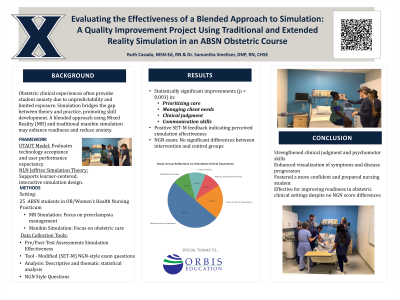Education
(25) Evaluating the Effectiveness of a Blended Approach to Simulation: A Quality Improvement Project Using Tradition and Extended Reality Simulation in an ABSN Obstetric Course
Friday, June 20, 2025
3:15 PM - 4:15 PM MST
Location: Plaza Ballroom Foyer


Ruth D. Casada, MSN-Ed., RN (she/her/hers)
Teaching Professor
Xavier University
Independence, Ohio, United States- SS
Samantha L. Smeltzer, DNP, RN, CHSE
Vice President, Simulation
Orbis Education
Indianapolis, Indiana, United States
Lead Author(s)
Co-Author(s)
Abstract : Background and Significance: Clinical experiences often increase anxiety in nursing students, particularly in maternity care, where patient complexity is unpredictable. Variability presents challenges in accurately assessing if course objectives are being met. High-quality simulation is an effective pedagogical tool to bridge the gap between theoretical knowledge and practical application. This study explored whether a blended approach of mixed reality and manikin simulation improved students’ cognitive and psychomotor skills, preparing them for diverse clinical situations. Framework: The Unified Theory of Acceptance and Use of Technology (UTAUT) and NLN Jeffries Simulation Theory framed the study, emphasizing learner-centered environments and performance expectancy.
Methods: The study involved two sessions in an Obstetric/Women's Health Nursing Practicum: one focused on preeclampsia management using mixed reality, and the other on obstetrical care using traditional manikin-based simulation. Descriptive statistical analysis and thematic analysis were conducted on pre/post-tests, Simulation Effectiveness Tool – Modified (SET-M) results, and Next Generation NCLEX (NGN) exam questions.
Results: Results indicated significant improvements in (n=25) participants’ confidence in prioritizing care needs (p < 0.001), managing client needs (p < 0.001), applying clinical judgment (p < 0.001), and effective communication (p < 0.001). Themes emerged from the SET-M submissions. NGN exam results showed no statistically significant differences between the study and control groups.
Conclusion: Integrating mixed reality with traditional simulation created a positive learning environment, enhancing visualization of clinical presentations, critical assessment skills, and understanding of disease progression, ultimately improving nursing students’ competency in managing clinical situations.
Please include a short summary of your presentation that highlights why an attendee would want to participate in your session.: The study aimed to reduce anxiety in nursing students in obstetric care by combining mixed reality with manikin simulations. It evaluated improvements in cognitive and psychomotor skills for complex clinical scenarios. Results indicated significant increases in confidence in prioritizing care, managing client needs, clinical judgment, and communication. The blended approach enhanced the learning environment and overall competency.
Methods: The study involved two sessions in an Obstetric/Women's Health Nursing Practicum: one focused on preeclampsia management using mixed reality, and the other on obstetrical care using traditional manikin-based simulation. Descriptive statistical analysis and thematic analysis were conducted on pre/post-tests, Simulation Effectiveness Tool – Modified (SET-M) results, and Next Generation NCLEX (NGN) exam questions.
Results: Results indicated significant improvements in (n=25) participants’ confidence in prioritizing care needs (p < 0.001), managing client needs (p < 0.001), applying clinical judgment (p < 0.001), and effective communication (p < 0.001). Themes emerged from the SET-M submissions. NGN exam results showed no statistically significant differences between the study and control groups.
Conclusion: Integrating mixed reality with traditional simulation created a positive learning environment, enhancing visualization of clinical presentations, critical assessment skills, and understanding of disease progression, ultimately improving nursing students’ competency in managing clinical situations.
Please include a short summary of your presentation that highlights why an attendee would want to participate in your session.: The study aimed to reduce anxiety in nursing students in obstetric care by combining mixed reality with manikin simulations. It evaluated improvements in cognitive and psychomotor skills for complex clinical scenarios. Results indicated significant increases in confidence in prioritizing care, managing client needs, clinical judgment, and communication. The blended approach enhanced the learning environment and overall competency.
Learning Objectives:
- Upon completion, participants will describe the benefits of combining mixed reality and traditional manikin simulations in education to enhance learning for the obstetric nursing specialty.
- Upon completion, participants will recognize how blended simulation enhances student learning, fostering a more effective learning environment for managing complex clinical situations.
- Upon completion, participants will articulate the improvements in cognitive and psychomotor skills observed in students engaging in simulation experiences, highlighting their enhancement in clinical judgment skills
- Upon completion, participants will assess the effectiveness of robust simulation experiences in nursing programs and discuss how blended simulation techniques can enhance student performance in clinical settings.

